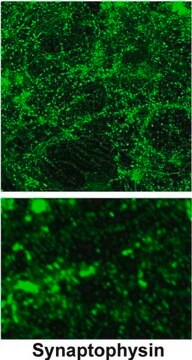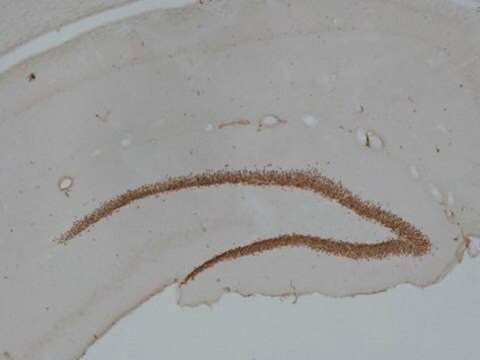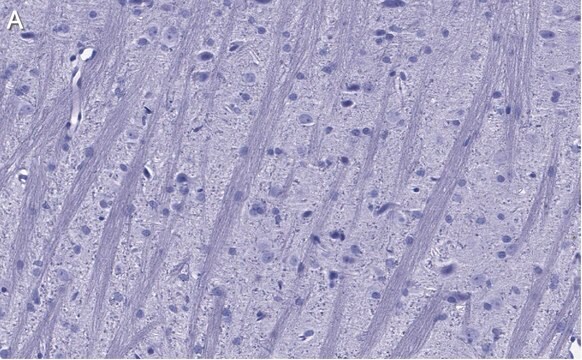MAB5258
Anti-Synaptophysin Antibody, clone SY38
clone SY38, Chemicon®, from mouse
Sinônimo(s):
synaptophysin, Synaptophysin
About This Item
Produtos recomendados
fonte biológica
mouse
Nível de qualidade
forma do anticorpo
purified immunoglobulin
tipo de produto de anticorpo
primary antibodies
clone
SY38, monoclonal
reatividade de espécies
bovine, rat, avian, fish, mouse, human
fabricante/nome comercial
Chemicon®
técnica(s)
flow cytometry: suitable
immunocytochemistry: suitable
immunohistochemistry: suitable
western blot: suitable
Isotipo
IgG1κ
nº de adesão NCBI
nº de adesão UniProt
Condições de expedição
wet ice
modificação pós-traducional do alvo
unmodified
Informações sobre genes
human ... SYP(6855)
Descrição geral
Especificidade
Imunogênio
Aplicação
A previous lot of this antibody was used in Flow Cytometry.
Western Blot:
(Provoda, 2000) Reacts with a 38 kDa transmembrane glycoprotein
Immunohistochemistry:
For relatively cytoplasm-rich neuroendocrinic tumors a final concentration of 1 µg/mL is recommended. Concerning cytoplasm deficient tumors a concentration of 2 µg/mL should be used. Ideal frozen sections (4-5 mm) are obtained from shock-frozen tissue samples. The frozen sections are air-dried and then fixed with acetone for 5-10 min at -20°C. Excess acetone is allowed to evaporate at room temperature. Material fixed in alcohol or formalin and embedded in paraffin can also be used.
It is advantageous to block unspecific binding sites by overlaying the sections with fetal calf serum for 20-30 min at room temperature. Excess of fetal calf serum is removed by decanting before application of the anti-body solution.
Cytocentrifuge preparations of single cells or cell smears are also fixed in acetone. These preparations should but should be followed directly by antibody treatment.
Optimal working dilutions must be determined by end user.
Neuroscience
Synapse & Synaptic Biology
Qualidade
Western Blot Analysis:
1:1000 dilution of this lot detected synaptophysin on 10 μg of mouse brain lysates.
Descrição-alvo
Ligação
forma física
Armazenamento e estabilidade
Nota de análise
Positive Control: Pancreas tissue
Negative Control: Normal mouse serum
Rat hippocampus tissue, mouse brain lysate.
Outras notas
Informações legais
Exoneração de responsabilidade
Não está encontrando o produto certo?
Experimente o nosso Ferramenta de seleção de produtos.
recomendado
Código de classe de armazenamento
10 - Combustible liquids
Classe de risco de água (WGK)
WGK 2
Ponto de fulgor (°F)
Not applicable
Ponto de fulgor (°C)
Not applicable
Certificados de análise (COA)
Busque Certificados de análise (COA) digitando o Número do Lote do produto. Os números de lote e remessa podem ser encontrados no rótulo de um produto após a palavra “Lot” ou “Batch”.
Já possui este produto?
Encontre a documentação dos produtos que você adquiriu recentemente na biblioteca de documentos.
Nossa equipe de cientistas tem experiência em todas as áreas de pesquisa, incluindo Life Sciences, ciência de materiais, síntese química, cromatografia, química analítica e muitas outras.
Entre em contato com a assistência técnica








